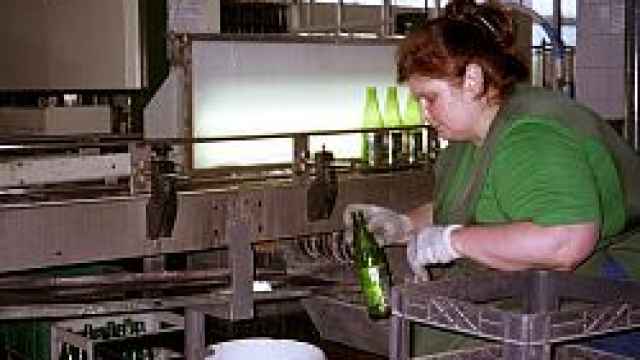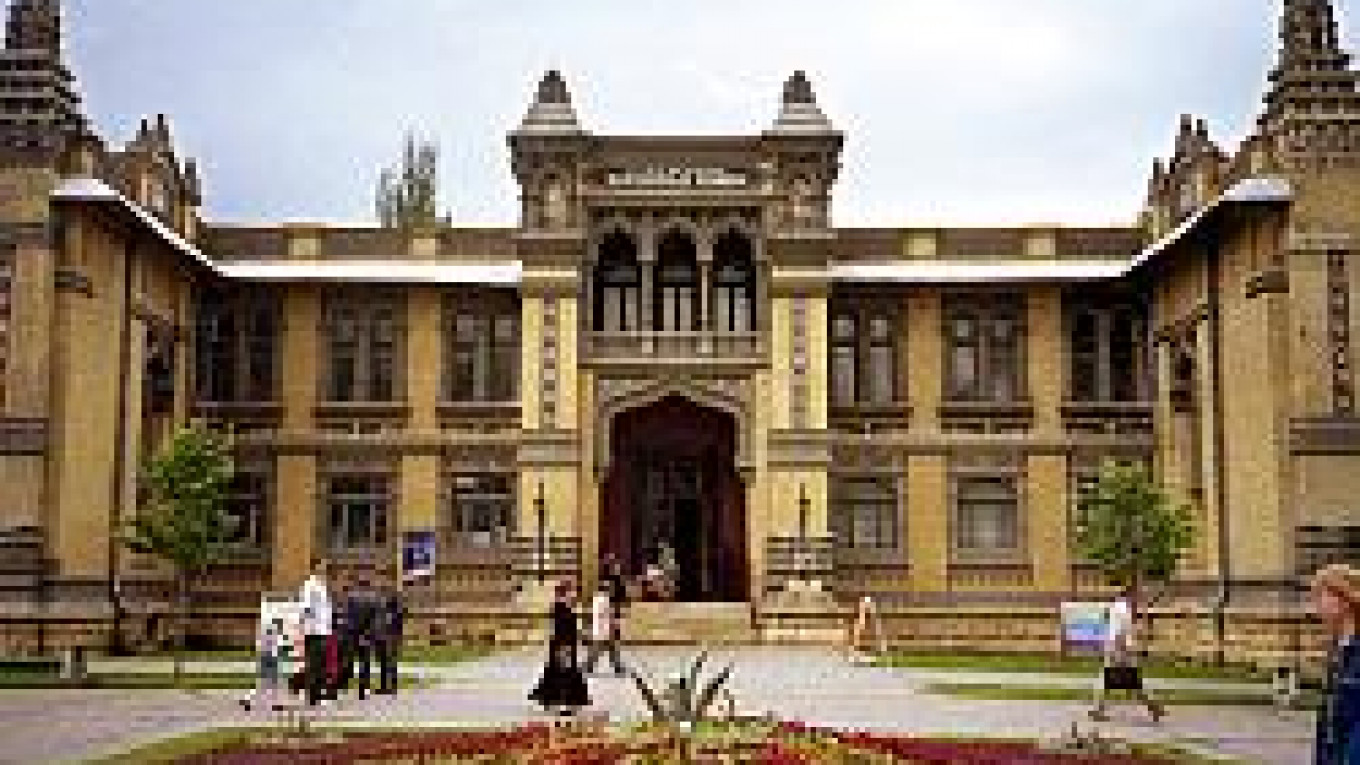But just a few years ago it looked like Narzan's good name would not be enough to save the company from going under.
In the chaos of post-communist Russia, the eminent old plant had to stoop to producing slippers and cheap booze. Counterfeiters tried to rip off the Narzan label.
Now Narzan says it's turning a profit. In May it scored a $12 million loan from a big foreign lender -- a rare accomplishment in this hardscrabble region.
The turnaround was anything but easy.
"The [Soviet] period of stagnation encouraged a person to steal," said company director Andrei Ivanov, reclining in his chair in his spartan office.
"It takes a long time to change old habits, and we've had to use the policy of the stick over the carrot with our employees here."
When communism collapsed, Narzan had immaterial assets that most other domestic enterprises could only dream of -- a pre-Revolutionary brand name, an established reputation and a quality product.
But in everything else it was like any other company emerging from the dysfunctional -- if secure -- command economy.
When regular orders from the state dried up, the factory was forced to switch to products targeted at mass consumers: cheap fortified wine and bedroom slippers.
It was quite a step down from the days when the company made special deliveries to ailing Soviet leader Vladimir Lenin in the 1920s.
To make matters worse, Narzan's equipment was beginning to fall apart. There was zero investment and a corporate culture that would put Enron to shame.
Shipments went "missing" by the truckload.
If theft wasn't bad enough, dozens of small-time counterfeiters started churning out fakes, as an exhibit of 20 bottles of all shapes and sizes attests to in the factory museum.
Today Narzan wants to portray itself as a forward-looking, transparent company that uses Western approaches to increase shareholder value.
Two years ago, the company hired U.S.-educated Vyacheslav Sinadski to develop a strategy and attract capital from a Western lending institution.
It succeeded on one count: In May, Narzan secured a loan from the European Bank of Reconstruction and Development to buy new equipment and launch a marketing campaign.
But the company is still far from transparent.
Narzan refuses to disclose its core shareholder, except to say that he is a Moscow businessman who built his fortune on oil.
Sinadski said the man has good reason to remain in the shadows, as the director of a rival plant was murdered shortly before a merger.
 Simon Ostrovsky / MT Part of a $12 million EBRD loan will go toward automating work long done by people. | |
When Narzan's secretive core shareholder and a minority of others bought out the company in 1994, he built a modern plastic bottling unit and put an end to the theft problem.
"The important thing is that there is an owner. He's not going to steal from himself, after all, and won't let others, either," Ivanov said.
Stiff penalties that can equal a third of a worker's salary have helped curtail disappearances, he said.
The company now outperforms its Soviet peak of 45 million liters per year by some 25 million liters and is back on the tables of the nation's elite, including the Kremlin.
Narzan's market share in bottled water is 2.4 percent in Russia's 25 largest cities, according to market tracker ACNielsen.
But Sinadski said the number is closer to 7 percent when taking into account only mineral water, as opposed to bottled drinking water in general.
Narzan aims to double that share in the next three years on the back of a market that is growing by 25 percent per year.
Aggressive marketing from Coca Cola's BonAqua and Pepsi's Aqua Minerale brands make expansion a challenge for established names like Narzan and its Georgian counterpart, Borjomi.
In a poll of drinkers of bottled water last year, Comcon market research group found that 23 percent of respondents said they had consumed Narzan within a three-month period.
Narzan mineral water was placed fourth nationally after Aqua Minerale, BonAqua and Borjomi.
"[Narzan] is holding on to its market niche but the niche is contracting," Comcon said in its report.
Narzan's main consumers are in the 35 to 45 age group, people who associate the drink with their youth in the Soviet Union.
But the company is now trying to change its image as a holdover from the Soviet era by sinking $3 million into its first-ever advertising campaign, aimed at younger, upwardly mobile consumers.
Borjomi and Yessentuki -- Narzan's main competitors in the natural mineral water market -- have the disadvantage that a number of companies hold licenses to produce mineral water under their names.
This "confuses consumers, casts doubt on the authenticity of the product and dilutes the brands," Comcon said.
Narzan, on the other hand, designed a distinctive hard-to-copy bottle and dragged companies using the Narzan brand through the courts, winning an important legal battle that gave it exclusive rights to the name and sources of the water.
It also helps that the name is distinctive and marketable, as "Narzan" derives from a word in a local language meaning "drink of warriors."
The history of Kislovodsk is steeped in its water: The town's name means "sour water" in Russian.
The area's healing waters were first mentioned in writing by the medieval Arab traveler Ibn-Battuta in the 14th century.
But to Russians the resort came into vogue after Peter the Great ordered one of his leading naturalists, German-born Peter Simon Pallas, to explore the springs there so that they would one day rival those in Western Europe.
By the 19th century, Kislovodsk became a spa for Russia's upper crust, attracting writers Mikhail Lermontov and Alexander Pushkin, and later, singer Fyodor Shalyapin.
The resort preserved its popularity during the Soviet era. After the Chernobyl nuclear disaster, victims were sent to Kislovodsk for the "Narzan treatment," which was believed to help wash out radionuclides.
Despite its illustrious past, today Kislovodsk is associated with two devastating commuter train bombings that killed a total of 48 people last year, a gruesome reminder to potential investors that the war in Chechnya is only 150 kilometers away.
The plant's investor, the EBRD, said that improving the region's troubled image was an important reason for its investment in Narzan.
But before the EBRD sent representatives to Kislovodsk to scout out the plant, the London-based bank took heed of the fact that the North Caucasus has one of the highest kidnapping rates in the world by dispatching a security specialist to the area first.
"We wined and dined him and showed him around until he went back satisfied everything was in order," Sinadski said.
But it was likely the bank was more interested in whether Narzan had the makings of a sound investment.
The EBRD ended up spending $12 million to give Narzan a loan and to buy an undisclosed stake in the company.
When the deal was announced in May, EBRD agribusiness team director Hans Christian Jacobsen said the project should send "an important signal to those thinking of doing business in the area."
A Message from The Moscow Times:
Dear readers,
We are facing unprecedented challenges. Russia's Prosecutor General's Office has designated The Moscow Times as an "undesirable" organization, criminalizing our work and putting our staff at risk of prosecution. This follows our earlier unjust labeling as a "foreign agent."
These actions are direct attempts to silence independent journalism in Russia. The authorities claim our work "discredits the decisions of the Russian leadership." We see things differently: we strive to provide accurate, unbiased reporting on Russia.
We, the journalists of The Moscow Times, refuse to be silenced. But to continue our work, we need your help.
Your support, no matter how small, makes a world of difference. If you can, please support us monthly starting from just $2. It's quick to set up, and every contribution makes a significant impact.
By supporting The Moscow Times, you're defending open, independent journalism in the face of repression. Thank you for standing with us.
Remind me later.


